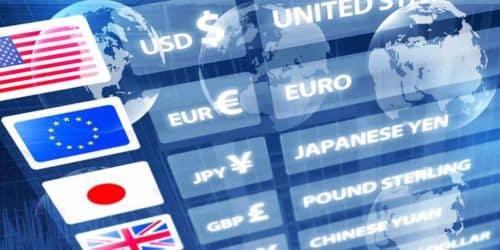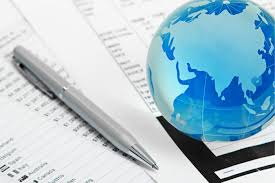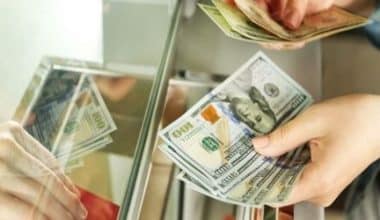For hundreds of years, gold was used to back up currencies all across the world. That is, each piece of paper currency reflected an actual amount of gold stored in a vault by the issuing government. The gold standard was a technique that governed international currency exchange rates until the early twentieth century. However, gold supplies eventually became insufficient to supply the demand for currency. The United States abandoned the gold standard in the early 1970s. This meant that market forces would determine the value of the dollar, and the international monetary system would be based on the dollar and other paper currencies.
Here’s all you need to know about currency exchange rates and how they are determined.
What Is an Exchange Rate?
An exchange rate is the price at which one currency is exchanged for another, and it influences trade and money flow between countries.
Both the native currency value and the foreign currency value influence exchange rates. The exchange rate from US dollars to Euros in July 2022 was 1.02, which means that $1.02 buys €1.
Currency Exchange Rates Explained
The exchange rate between two currencies is generally decided by each country’s economic activity, market interest rates, gross domestic product, and unemployment rate. They are set in the global financial marketplace, where banks and other financial organizations trade currencies around the clock depending on these criteria, and are sometimes referred to as market exchange rates. Rate adjustments can occur hourly or daily, with little or significant incremental alterations.
The acronym for the national currency that an exchange rate represents is widely used. For example, USD stands for the United States dollar, whereas EUR stands for the Euro. EUR/USD is the currency pair that represents the dollar and the euro. It’s USD/JPY, or dollar to yen, in the case of the Japanese yen. A conversion rate of 100 signifies that one dollar equals 100 yen.
Types of Exchange Rate Systems
In the foreign exchange market, there are three types of exchange rate systems in use, which are as follows:
#1. Fixed exchange rate system or pegged exchange rates
The pegged exchange rate or fixed exchange rate system is one in which the weaker currency of the two in question is pegged or bound to the stronger currency.
Fixed exchange rates are determined by the country’s government or central bank and are not affected by market factors.
To preserve currency rate stability, the central bank or government purchases foreign exchange when the rate of foreign currency rises and sells foreign currency when the rate falls.
This is known as pegging, and it is for this reason that the fixed exchange rate system is also known as the pegged exchange rate system.
The Benefits of the Fixed Exchange Rate System
- It promotes foreign trade by ensuring currency stability.
- The value of currency is stable, which protects it from market volatility.
- It encourages foreign investment in the country.
- It aids in the maintenance of steady inflation rates in an economy.
The Drawbacks of the Fixed Exchange Rate System
- Maintaining foreign reserves is always necessary in order to keep the economy stable.
- The government may lack the flexibility required to recover in the event of an economic crisis.
#2. Flexible/Floating Exchange Rate System
Because it is based on market forces of supply and demand, the flexible exchange rate system is also known as the floating exchange rate system.In the floating exchange rate system, neither central banks nor governments intervene.
The Benefits of a Floating Exchange Rate System
- There is no need to keep foreign reserves under this currency system.
- In this arrangement, any deficits or surpluses in the Balance of Payments are immediately adjusted.
The Drawbacks of the Floating Exchange Rate System
- It encourages speculation, which may result in volatility in the market exchange rate of currencies.
- Excessive swings in currency rates can generate problems with capital movement between countries and have an influence on overseas trade.
- It will deter all forms of international trade and foreign investment.
#3. Managed Floating Exchange Rate System
A managed floating exchange rate system is a hybrid of fixed and floating exchange rate systems. Central banks intervene or participate in the acquisition or sale of foreign currencies under this arrangement.
Factors Influencing The Exchange Rate
#1. Floating Interest Rates
The market dynamics of supply and demand determine floating rates. The value of a currency in respect to another currency is determined by how much demand there is in ratio to supply.
For example, if European demand for US dollars rises, the supply-demand relationship will lead the price of the US dollar to rise in comparison to the euro.
There are several geopolitical and economic announcements that affect exchange rates between two countries, but some of the most common are interest rate adjustments, unemployment rates, inflation statistics, GDP numbers, manufacturing data, and commodities.
#2. Fixed Rates
The government determines a fixed or pegged rate through its central bank. The rate is determined in relation to another major world currency (for example, the US dollar, euro, or yen). The government will buy and sell its own currency against the currency to which it is tied in order to preserve its exchange rate.
Short-term movements in a floating exchange rate currency reflect speculation, rumors, natural calamities, and the currency’s daily supply and demand. If supply exceeds demand, the currency will fall; if demand exceeds supply, the currency will increase.
Even in a floating-rate regime, extreme short-term swings can lead to central bank intervention. As a result, while most major world currencies are considered floating, central banks and governments may intervene if a country’s currency becomes too high or excessively cheap.
A currency that is too high or too low may have a negative impact on the nation’s economy, impacting trade and the ability to pay obligations. The government or central bank will try to put measures in place to move its currency to a more favorable price.
#3. Macroeconomic Factors
Exchange rates are influenced by a variety of macroeconomic factors. The “Law of One Price” states that in an international trade world, the price of a good in one country should be the same as the price in another. This is known as purchasing power parity (PPP).
If prices become out of whack, a country’s interest rates will shift—or the exchange rate between currencies will alter. Of course, reality does not always follow economic theory, and the law of one price does not always apply in practice due to a variety of mitigating factors. Nonetheless, interest rates and relative prices will have an impact on exchange rates.
Another macro factor is geopolitical risk and a country’s government’s stability. If the government is unstable, the country’s currency is likely to lose value in comparison to more developed, stable nations.
#4. Commodities and Foreign Exchange
In general, the stronger the association between the national currency and the commodity prices of a country’s principal domestic industry.
There is no universal method for establishing which commodities are connected with a certain currency and how strong that correlation is; however, several currencies provide good instances of commodity-forex linkages.
Consider that the Canadian dollar has a positive relationship with the price of oil. As a result, as the price of oil rises, the Canadian dollar tends to strengthen against other major currencies. This is due to the fact that Canada is a net oil exporter; when oil prices are high, Canada tends to reap higher income from its oil exports, providing the Canadian dollar a boost in the foreign exchange market.
The Australian dollar is another notable example, as it is favorably associated with gold. Because Australia is one of the world’s largest gold producers, its currency tends to fluctuate in lockstep with fluctuations in gold bullion prices. As a result, when gold prices climb significantly, the Australian dollar is projected to rise against other major currencies.
#5. Maintaining Rates
Some countries may choose to utilize a pegged exchange rate that is artificially fixed and maintained by the government. This rate will not change intraday and may be reset on specific revaluation occasions.
Emerging market governments frequently do this to stabilize the value of their currencies. To maintain a stable pegged foreign exchange rate, the country’s government must maintain considerable reserves of the currency to which its currency is tied in order to regulate variations in supply and demand.
Finding and Interpreting Exchange Rates
Exchange rates can be found in a variety of places, including banks and websites such as XE.com. When traveling, you can frequently see rates listed at airports or local banks. Look at your trading platform for real-time information if you trade in the foreign exchange (“forex”) market.
Because currency values are always relative to one another, quotes are usually offered in pairs. Due to their prominence as reserve currency at many worldwide central banks, the US dollar and euro are the two most widely mentioned currencies. As a result, the most common currency pair is the EUR/USD, which is the number of dollars required to acquire one euro.
These currency pairs are constantly fluctuating due to a variety of economic reasons such as supply and demand, various economic indices, commercial and hedging activities, and hedge fund or financial trading. The fluctuations are small fractions of a currency’s value, referred to as “pips” by currency traders.
It’s also worth mentioning that many airport currency exchangers profit by charging a larger margin between currencies. They do not charge a fee, but they profit from inflating exchange rate disparities. Exchanging currencies through your local or international bank frequently provides the best value.
Calculating Exchange Rates
Calculating exchange rates may appear simple on the surface, but if you don’t remember much math from school, it might be difficult. It’s simple to change $100 to foreign currency while traveling, but converting currencies when reviewing the financial statements of a foreign firm might make a major difference when making investment decisions.
Consider the following example of how to compute exchange rates.
Assume the EUR/USD exchange rate is 1.20 and you want to convert $100 USD into euros. Simply multiply $100 by 1.20. The outcome is a total of 83.33 euros. Converting euros to US dollars is the inverse of that process: To convert euros to US dollars, multiply the number of euros by 1.20.
One simple approach to remember this is to multiply left to right and divide right to left. The desired outcome of the calculation is the resulting currency. In the preceding example, we divided it right to left to discover how many euros we could buy in US dollars. Then we multiplied left to right to determine how many US dollars we’d earn from euros.
When you’re traveling, you might merely want to know how much your money is worth, but currency traders who are heavily leveraged pay attention to every pip. A tiny currency fluctuation matters a lot to an overseas investor calculating the impact of a $0.0001 variation on $1 billion in income.
How Do Exchange Rates Affect Goods Supply and Demand?
Changes in exchange rates have an impact on businesses by affecting the cost of commodities obtained from a different country as well as the demand for their products from overseas clients.
What Is a Restricted Currency?
Within the same country, exchange rates might vary. Some countries have restricted their currencies, limiting their exchange to within their boundaries, and there is frequently an onshore rate and an offshore rate. A more favorable exchange rate is often obtained within a country’s borders rather than beyond its borders, and the value of a limited currency is established by the government. China is an example of a country with this rate structure and a government-controlled currency. The Chinese government sets a midpoint value for the currency every day, allowing the yuan to trade in a 2% band around the midpoint.
In Conclusion
An exchange rate is the price at which one currency is exchanged for another. While most exchange rates are floating and will rise and fall in response to market supply and demand, some exchange rates are pegged or fixed to the value of a specific country’s currency. Exchange rate changes have an impact on businesses and the cost of supplies as well as demand for their products in the international marketplace.






